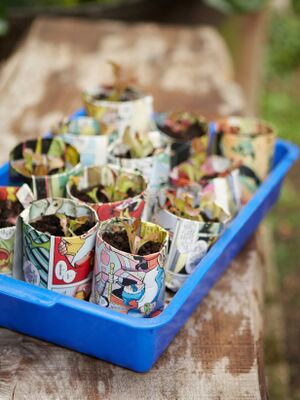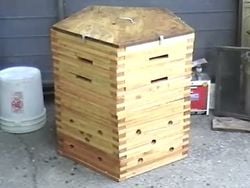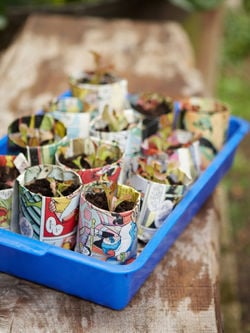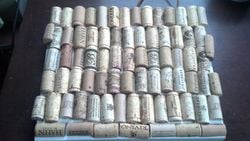
#1 Buy Bulk Food: Cut down on packaged products by buying in bulk while reusing your bags and twist ties. Cutting down on the packaging used helps save on: energy used in the production process, resources, and eliminates extra garbage from the waste stream. For perspective, 40% of what Americans throw away each year is packaging. You can also reuse packaging from other items like jam jars and yogurt containers to store your food as well as reduce your waste.
#2 Household Cleaners: Vinegar and baking soda are great natural cleaners. Baking soda is good for scrubbing tiles, showers, sinks, and other hard surfaces due to its abrasive nature. Making a paste of baking soda and water is good for oven scrubbing! Vinegar is best for cleaning mirrors and glass. To get a truly shiny shine, use a bit of vinegar with an old crumpled newspaper. Baking soda and vinegar can also be used together, for fizzy bathroom cleaning fun. Stop by CCAT for more ideas on non-toxic, natural house cleaning alternatives.
#3 High Efficiency Light Bulbs: Move over Compact Florescents, the LED is here! While the CFL still has low power requirements (about 13 Watts compared to the average Incandescent bulb's 60 Watts), it does not have as long a life span as the LED. A CFL bulb can last an average of 8,000 hours while the LED can last up to 50,000 hours. That's a lot of hours. Choosing a lower wattage light bulb will help save you money on your electric bill as well as save resources used to generate electricity. Click on the link above to compare light bulbs and choose which one is right for you.
#4 Compost Bucket or Worm Bin: Put your food scraps back into the cycle of nature by turning them into valuable compost, instead of throwing them away. Compost is formed through the decomposition of food and garden waste, making a nutrient rich product that you can use in your garden. A worm bin follows the same principle, but allows worms to munch on your leftovers and help in your compost creation. Worms also leave behind their casings, which your plants will love and appreciate. For more information on composting check out the CCAT Compost System.

#5 Thermal Curtains: Help to stop cold drafts from coming in through your windows and valuable heat from escaping. To get the most bang for your buck with your thermal curtains, pull them back in the day to let the sun shine in, and in the evening close the curtains to keep the solar energy in. Keeping the solar radiation as well as body heat in and not letting it escape out your window will help you save on your heating bill and keep your house much warmer at night. CCATsells thermal curtains, or you can look at the CCAT quick and dirty side pull thermal curtain howto page to get an idea of how to make your own.
#6 Keep the Refrigerator and Freezer full: Frozen or cold food items keep the fridge temperature cold, thereby decreasing the frequency of cooling cycles (and energy used!). Jugs of water can be used if necessary. Also, keeping the coils clean and providing a ventilation space will increase fridge efficiency. This same principle can be used in CCAT cold box, which take in cool air from the outdoors to chill your fruits and vegetables. For more information on high efficiency refrigeration visit http://www.sunfrost.com/.
#7 Container Gardens: Grow some of your own herbs and vegetables in containers that can be moved easily, if you don't have access to an outdoor garden. Indoor plants are a great option, because they brighten up a room and can grow happily indoors even when it's not their growing season. Containers can be purchased or re-used, or you can make your own! For seedlings and starts, small newspaper pots are a good option. Newspaper pots are a sustainable option because they are made of organic material and thus are compostable, meaning you can put your plant right into the soil and let the newspaper decompose. If you're particularly artsy, ceramic pots are another great homemade option.

#8 A Recycled Material Household: Tap into the urban waste stream to make home furnishings! A wood pallet can be used to make mattress box springs. Milk crates can be turned into shelving. Old wine corks can be used to make your own recycled cork board. Scrap wood could make you a bedside table. Old beer or granola bar boxes have the perfect cardboard to be turned into a homemade recycled journal. Before throwing something away, consider how it can be used again around your home.

#9 Reduce, Reuse, Rethink, Recycle: Look for ways to reduce your daily resource consumption. Think of ways to reuse the byproducts of your consumption (i.e. reuse cans and bottles, do dishes in portable bucket so grey water can be used for landscape irrigation etc.). Rethink your lifestyle patterns and 'needs' to see if there are excesses that can be avoided in the future or if alternatives exist. Recycle everything that you can as a last option after reducing, reusing and rethinking.
#10 Be Conscious: Of your energy use! Turn electronics off when not in use and be aware of phantom loads (electrical devices continue to draw power even when 'off' so long as they are plugged in). One way to ensure electronics get turned off and phantom loads are eliminated is: to use power strips. Simply turn off the entire strip when you are done using something and you can be sure that there is no more power being drawn to the device. This is a lot simpler than unplugging everything when you are done with it!
#11 Decrease Fossil Fuel Consumption: By walking, riding your bike, carpooling, or taking public transit. Fossil fuel consumption can also be indirectly reduced by eating less meat and dairy products. Meat production is a very energy intensive process and as more and more humans reach middle class status, more and more meat is being consumed. Cutting back on the meat is a god way to cut back on the fossil fuels.
#12 Support your Neighbors: Buy locally grown and/or produced goods whenever possible. Buying locally not only supports your community, but also reduces the miles traveled by everything we buy. Less transportation means less gasoline burned and less greenhouse gases released.
More information is available by visiting the Campus Center for Appropriate Technology, located next to the BSS and across from the Schatz lab on the Cal Poly Humboldt campus. Or visit the CCAT website.
Updated by: Akr57 20 April 2015
Original post by: Sendog6913 17:30, 2 March 2008 (PST) Cal Poly Humboldt - CCAT